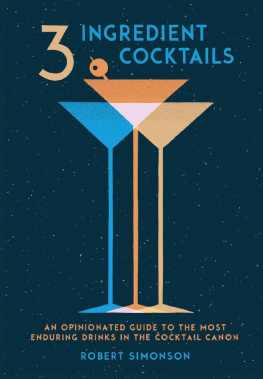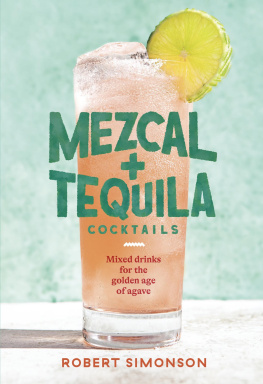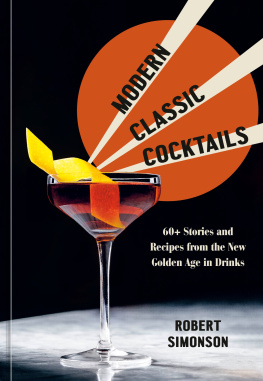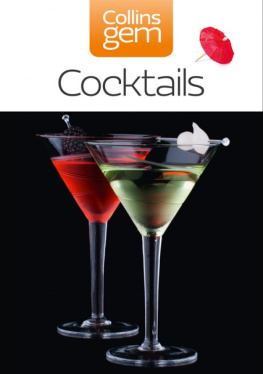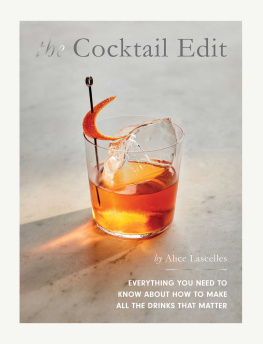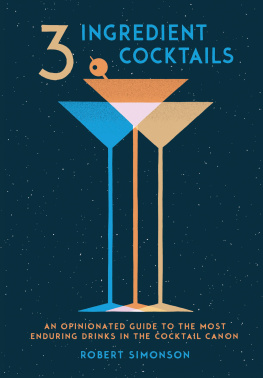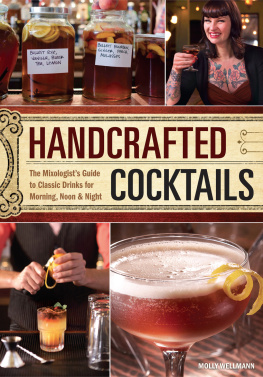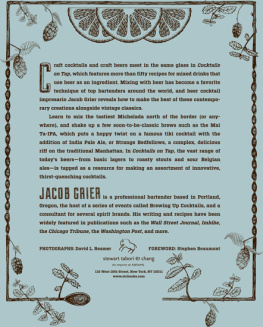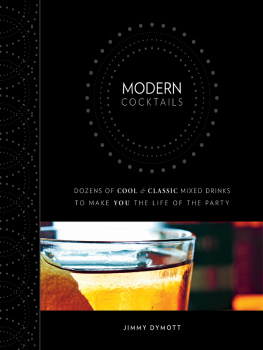ALSO BY ROBERT SIMONSON
The Old-Fashioned: The Worlds First Classic Cocktail, with Recipes and Lore
A Proper Drink: How a Band of Bartenders Saved the Civilized Drinking World
Copyright 2017 by Robert Simonson
Photographs copyright 2017 by Colin Price
All rights reserved.
Published in the United States by Ten Speed Press, an imprint of the Crown Publishing Group, a division of Penguin Random House LLC, New York.
www.crownpublishing.com
www.tenspeed.com
Ten Speed Press and the Ten Speed Press colophon are registered trademarks of Penguin Random House LLC.
Portions of the section on the Gibson first appeared, in slightly different form, in Grub Street.
Portions of the sections on the Mint Julep and Sidecar first appeared, in slightly different form, in Punch.
Portions of the section on the Daiquiri first appeared, in slightly different form, in Saveur.
Library of Congress Cataloging-in-Publication Data is on file with the publisher.
Hardcover ISBN9780399578540
Ebook ISBN9780399578557
Cover design by George Carpenter
Cover illustration by Matthew Allen
Drink styling by Emily Caneer
Prop styling by Glenn Jenkins
v4.1_r2
prh
C ontents
D rinks
OLD-FASHIONED COCKTAILS
IMPROVED COCKTAILS
SOURS
HIGHBALLS
OTHER COCKTAILS
I ntroduction
You need three ingredients for a cocktail. Vodka and Mountain Dew is an emergency.
PEGGY OLSON , M ad M en
Threeits a magic number.
We see in three dimensions. Three strikes, youre out. Three-pointers are the highlight of any basketball game. Baby makes three. Reading, writing, and rithmatic makes an education. Three is a hat trick. Threes a charm. Ready, set, go. One, two, three: take the picture. Nobody counts to two. Nobody counts to four. Three makes magic.
The triangle is the most stable of shapes, so it comes as no surprise, then, that the three-ingredient cocktail is the most sturdy and lasting of cocktail constructions. One ingredient, youve got a nice dram. Two, youve got a highball. Get three things to marry together, youve likely got a cocktail on your hands. More than three and youve got a more complicated cocktail, not necessarily a better one.
Since the cocktail renaissance began around the turn of the twenty-first century, detractors have been complaining that too many of the new drinks being turned out by mixologists contain a surfeit of ingredients. So what? I often thought. If it leads to deliciousness, who cares if they threw in the kitchen sink and a pair of cufflinks?
Except, those detractors had a point. Complexity may lead to the flattery of the senses, but not to imitation. If the Manhattan had eight ingredients, nobody would be making it todayat least, not at home and probably not at many bars. There is practicality in the three-ingredient cocktail. Because you dont need a grocery cart when shopping for its fixins at the liquor store, if its tasty, it will catch on. Whiskey, vermouth, bitters? You got this.
Theres also honesty in the three-ingredient cocktail. When you get past five ingredients in a drink, the further additives are often there, not to add to whats already present in the glass, but to correct whats still lacking in the mixture. If you spot a drink on a menu that has seven or eight things in it, chances are two of those are Band-Aids, attempting to mend a broken cocktail. Thats not possible with a trio. There are no obfuscating ingredients the purpose of which might be to cloud the drinkers mind and mask some innate unsoundness of the drink. You can clearly taste and adjudge every component. Every player must be strong. As bartender Audrey Saunders once said, The three-ingredient cocktail doesnt lie.
Finally, the three-ingredient cocktail has history on its side. Every time the cocktail world has stirred up dust within the great culture, its because some three-legged liquid creature has ventured, all big-footed, onto the worlds Main Street: the Whiskey Cocktail, Mint Julep, Manhattan, Martini, Tom Collins, Whiskey Sour, Daiquiri, Margarita, Moscow Mule, Negroni, and Harvey Wallbangerall three-ingredient game-changers. Triumphal triptych cocktails dont provoke arguments about whether theyre good or not; they start arguments about the best way to make them well. Its taken as an article of faith that theyre good.

This is all a lot of words to justify something that doesnt really need justifying. Most everyone agrees there is some innate virtue in simplicity, whatever field of endeavor youre talking about. If you dont even agree to that, thats finecontrary away. Im the first to admit, in terms of cocktails, that its possible to make a fairly solid argument for any style or method you choose to get behind. Think more is more? A lot of tiki drink aficionados would agree with you. Think that sous vide method brings out the flavor more strongly? Science has a case to make. I grant you all your points.
But this remains: these drinks are easy to make (point one), while none of them read on the tongue as simple-minded creations (point two), and they all taste good (point three). Give me an argument against that.
People often ask me what cocktails I make when I drink at home. The answer is, by and large, the ones included in these pages, the classics: Old-Fashioned, Manhattan, Daiquiri, Negroni, and so on. I turn to them regularly because they are delicious, dependable, and easy to prepare, and I almost always have the ingredients on hand. And if that is the situation for me, theres no reason it cant be the same with anyone reading this sentence. That was one reason for my writing this book. Another is that many of the cocktail books that have come out in recent years have been a little, well, fussy. Those volumes, put out by estimable bars and bartenders, all have something to offer. But perhaps this book can serve as an alternative.
While most of the cocktails that follow are well established and were invented decades ago, there are a number of new drinks. Finding those was more difficult, simply because hitting upon a solid, three-ingredient cocktail today is a tall order; most of the obvious formulae were laid down long ago. Still, I found a few worthy specimens of recent vintage.
Enough preamblelets move on to the drinkswith some history and opinion woven through.
A N ote on the R ecipes
Most three-ingredient drinks can be divided into two camps: (1) spirit, sweetener, bitters; and (2) spirit, sweetener, citrusbetter known as sours. The former are, generally speaking, the stiff customers; the latter, the piquant refreshers.
Next page
